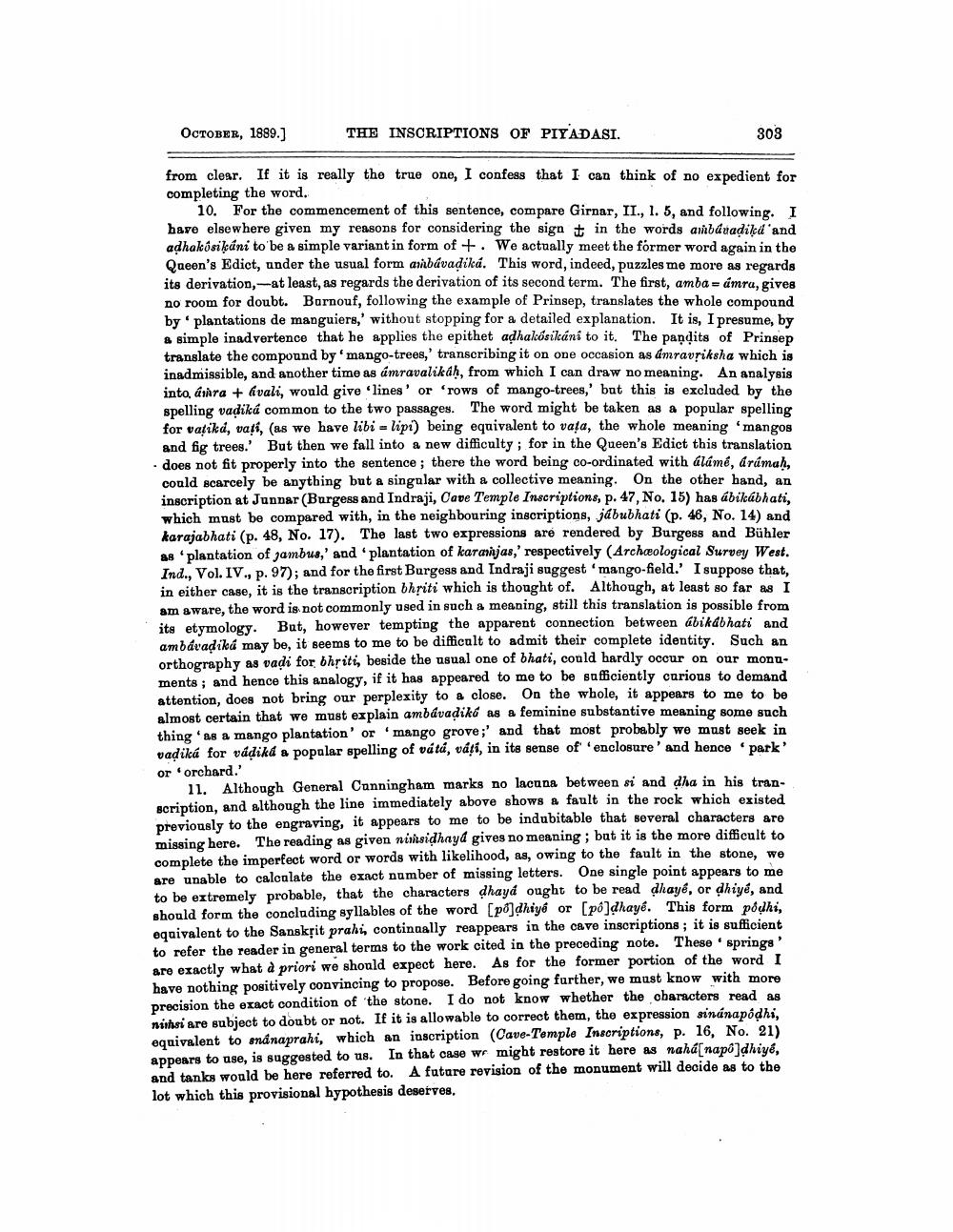________________
OCTOBER, 1889.]
from clear. If it is really the true one, I confess that I can think of no expedient for completing the word.
10. For the commencement of this sentence, compare Girnar, II., 1. 5, and following. I have elsewhere given my reasons for considering the sign in the words ambávaḍika and adhakosikáni to be a simple variant in form of +. We actually meet the former word again in the Queen's Edict, under the usual form ambávaḍiká. This word, indeed, puzzles me more as regards its derivation, at least, as regards the derivation of its second term. The first, amba= ámra, gives no room for doubt. Barnouf, following the example of Prinsep, translates the whole compound by plantations de manguiers,' without stopping for a detailed explanation. It is, I presume, by a simple inadvertence that he applies the epithet aḍhakésikáns to it. The pandits of Prinsep translate the compound by 'mango-trees,' transcribing it on one occasion as amravṛiksha which is inadmissible, and another time as ámravalikáḥ, from which I can draw no meaning. An analysis into, ámra +ávali, would give 'lines' or 'rows of mango-trees,' but this is excluded by the spelling vaḍiká common to the two passages. The word might be taken as a popular spelling for vatiká, vati, (as we have libi lipi) being equivalent to vata, the whole meaning 'mangos and fig trees.' But then we fall into a new difficulty; for in the Queen's Edict this translation does not fit properly into the sentence; there the word being co-ordinated with álámé, árámaḥ, could scarcely be anything but a singular with a collective meaning. On the other hand, an inscription at Junnar (Burgess and Indraji, Cave Temple Inscriptions, p. 47, No. 15) has abikábhati, which must be compared with, in the neighbouring inscriptions, jabubhati (p. 46, No. 14) and karajabhati (p. 48, No. 17). The last two expressions are rendered by Burgess and Bühler as 'plantation of jambus,' and 'plantation of karamjas,' respectively (Archaeological Survey West. Ind., Vol. IV., p. 97); and for the first Burgess and Indraji suggest 'mango-field.' I suppose that, in either case, it is the transcription bhriti which is thought of. Although, at least so far as I am aware, the word is not commonly used in such a meaning, still this translation is possible from its etymology. But, however tempting the apparent connection between ábikábhati and ambávaḍiká may be, it seems to me to be difficult to admit their complete identity. Such an orthography as vadi for bhriti, beside the usual one of bhati, could hardly occur on our monuments; and hence this analogy, if it has appeared to me to be sufficiently curious to demand attention, does not bring our perplexity to a close. On the whole, it appears to me to be almost certain that we must explain ambávaḍiká as a feminine substantive meaning some such thing as a mango plantation' or 'mango grove; and that most probably we must seek in vadika for váḍiká a popular spelling of vátá, váți, in its sense of 'enclosure' and hence 'park' or orchard.'
THE INSCRIPTIONS OF PIYADASI.
303
11. Although General Cunningham marks no lacuna between si and dha in his transcription, and although the line immediately above shows a fault in the rock which existed previously to the engraving, it appears to me to be indubitable that several characters are missing here. The reading as given nimsiḍhayd gives no meaning; but it is the more difficult to complete the imperfect word or words with likelihood, as, owing to the fault in the stone, we are unable to calculate the exact number of missing letters. One single point appears to me to be extremely probable, that the characters dhayd ought to be read dhayé, or dhiye, and should form the concluding syllables of the word [po]dhiyé or [po]dhaye. This form podhi, equivalent to the Sanskrit prahi, continually reappears in the cave inscriptions; it is sufficient to refer the reader in general terms to the work cited in the preceding note. These springs' are exactly what à priori we should expect here. As for the former portion of the word I have nothing positively convincing to propose. Before going further, we must know with more precision the exact condition of the stone. I do not know whether the characters read as nihsi are subject to doubt or not. If it is allowable to correct them, the expression sinanapôḍhi, equivalent to snánaprahi, which an inscription (Cave-Temple Inscriptions, p. 16, No. 21) appears to use, is suggested to us. In that case we might restore it here as nahá napo]dhiye, and tanks would be here referred to. A future revision of the monument will decide as to the lot which this provisional hypothesis deserves.




